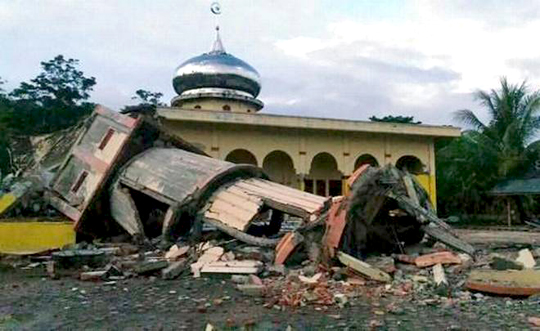Meureudu, Dec 7: The death toll from a powerful earthquake that struck western Indonesia on Wednesday has nearly doubled to 97, the military said, as more bodies were pulled from the rubble of scores of shattered buildings.

The shallow 6.5-magnitude quake struck Pidie Jaya district in Aceh province at dawn as many in the mainly Muslim region on Sumatra island were preparing for morning prayers.
The death toll has steadily climbed as rescue crews search, often by hand, through the homes, mosques and shops reduced to ruins.
The earlier figure of 52 dead was revised up significantly by the Indonesian military, which has taken over responsibility for the search and rescue operation.
"So far 97 people have been killed and the number keeps growing," Aceh military chief Tatang Sulaiman told AFP.
"When we retrieve bodies sometimes there's five, sometimes 10 corpses."
More than 1,000 soldiers and about 900 police have been deployed to the worst-hit areas to set up shelters and evacuation points, he added.
Hundreds of houses and shops had been levelled by the quake, leaving countless people homeless and in need of basic supplies like food and water, officials said.
"The electricity is still off. Some places have generators, but there are not many," local disaster agency head Puteh Manaf told AFP.
"If it rains there will be disease."
The sole hospital in Pidie Jaya was quickly overwhelmed, with patients treated on the grass out front or sent to neighbouring districts with better facilities.
The district health office chief Said Abdullah said nearly 200 injured had arrived since the quake, but many would not enter the hospital for fear of aftershocks.
"We are treating people outside. We took the beds out because nobody is daring enter the hospital," he told AFP.
Another regional hospital had suffered serious damage in the quake, along with schools and other key infrastructure, a national disaster agency spokesman said.
In the hard-hit town of Meureudu, terrified residents rushed outside as their homes buckled and crumbled.
"Everything was destroyed," said Hasbi Jaya, who pulled his two children unconscious from the rubble of their home.
"It was pitch black because the electricity was out. I looked around and all my neighbours' homes were completely flattened."
An AFP correspondent said dazed residents were wandering debris-strewn streets, unable to return to their damaged homes in fear of aftershocks.
Some fled to higher ground for fear of a tsunami although no alert was issued.
A huge undersea earthquake in 2004 triggered a tsunami that engulfed parts of Aceh and other countries around the Indian Ocean, killing more than 170,000 people in Indonesia alone.
Indonesian seismologists said the latest earthquake was felt across much of Aceh province, with many aftershocks following the initial tremor.
The US Geological Survey upgraded the magnitude to 6.5 from an initial reading of 6.4 and issued a yellow alert for expected fatalities and damage.
Indonesia experiences frequent seismic and volcanic activity due to its position on the Pacific "Ring of Fire", where tectonic plates collide.
Aceh lies on the northern tip of Sumatra island, which is particularly prone to quakes.
In June a 6.5-magnitude quake struck off the west of Sumatra, damaging scores of buildings and injuring eight people.





Comments
Add new comment